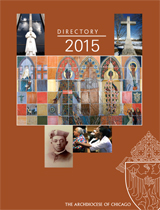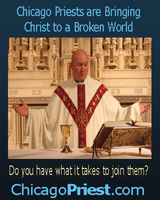Mother GuadalupeFor many Catholics, Mary – as she appeared to St. Juan Diego in 1531 – is a confidant, guide and special friend
Tens of thousands of people will come to the Our Lady of Guadalupe Chapel-Maryville for the festivities surrounding the feast of Our Lady of Guadalupe Dec. 12. Some will come for the spectacle, some will come to learn about the cultural aspects, but many will come because of a deep and abiding attachment to the Virgin who appeared to a Mexican native on the hill of Tepeyac in 1531.
She appeared as a virgin and mother, looking like a native princess herself. Histories say she helped bring the Mexican people to Christianity by appearing as one of them. Many people see her as a maternal figure, someone who understands and listens to them.
That was part of her appeal to San Juan Diego, who first encountered her on Dec. 9, 1531, and part of her appeal to the millions of native Mexicans who converted after her appearance.
When she spoke to Juan Diego, she called him her son. Those devoted to her also see her as mother figure. Following are some of their stories:
Leticia Herrera
Leticia Herrera spent the weeks leading up to Dec. 12, 2003, planning a big surprise birthday party for her mother, who was turning 75.
During the preparations, family members half-jokingly pointed out that maybe a surprise party for a 75-year-old wasn’t such a good idea; what if the shock brought on a heart attack or something?
But it was Herrera, then 49, who didn’t make it through the party. She collapsed, having suffered a ruptured brain aneurysm.
“The doctors told my family I wasn’t expected to make it through the night,” said Herrera, a Buffalo Grove resident who owns a grocery store in Wheeling.
She was taken first to Holy Family Medical Center in Des Plaines, then to Northwestern Memorial Hospital in Chicago, where doctors operated on her brain.
“They came out and told my family they had done everything they could. The rest was up to God,” Herrera said.
Her family had faith that God would bring her back, and they asked Our Lady of Guadalupe to carry that message. They prayed at the hospital and in their homes, in the Chicago area and in California and in Mexico. Her ex-husband brought a statue of the Virgin to her hospital room; the statue still stands in her bedroom.
Since her mother’s birthday is the feast day of Our Lady of Guadalupe, the family has long had a devotion to her, and turning to her in a time of need was only natural, Herrera said. They knew her story, including the healing of St. Juan Diego’s uncle, Bernardino.
Twenty-fours later, Herrera woke up, and knew everybody around her. Today, she suffers no ill effects from the aneurysm.
“They said it was a miracle,” she said.
Now Herrerra goes to the shrine at Maryville as often as she can, mostly in the evenings.
“I give thanks for my life,” she said. “I don’t ask for anything. I focus on the good. And I cry.”
Raul Campos
Two years ago, Raul Campos, 26, knew his life was headed in the wrong direction. He was a member of a street gang, drinking and using drugs.
“I was doing a lot of bad things,” said Campos, who lives with his family in Des Plaines.
His father encouraged him to learn more about his faith as a way to encourage positive choices, and Campos attended a youth retreat sponsored by the shrine.
“It was like I just got a wake-up call,” he said.
Now he’s a member of the shrine’s pastoral council and the youth group. He helps lead youth retreats, trying to convince young boys to avoid gang life.
“I wish someone had talked to me then,” he said. “I lost a lot of friends. I had one friend die in my arms.”
Campus tries to visit the shrine every day, sitting in the chapel and then visiting the image of Our Lady of Guadalupe outside.
“I look at it like a mother figure,” Campos said. “I talk to her. She responds through other people. She’s put a lot of good people in my path.”
For Campos, Our Lady of Guadalupe deserves thanks as the Mother of God.
“Without her, we don’t have Jesus,” he said. “She was his mother.”
He said he will continue to visit the shrine.
“I just get a sense of peace there,” he said. “Sometimes you have problems, and you worry too much. Being there makes me feel calm. It helps me with my temptations.”
Maria Avila
Maria Avila has known the Virgin of Guadalupe since she was a child and she watched her mother pray before the image.
Now Avila, a 45-year-old married mother of two, maintains the tradition, praying with an image of Our Lady of Guadalupe in her Marengo home and, usually more than once a week, at the Maryville-Our Lady of Guadalupe Chapel in Des Plaines.
“I go every Sunday,” said Avila, who teaches religious education classes there. “And sometimes on Saturdays, and sometimes during the week. I work on the second shift so I can go during the day.”
It’s been for about two years that Avila has made the trip so often, she said. Before, she usually went on Sundays, sometimes every other Sunday.
But since finishing treatment for breast cancer in 2005, she has gone to give service to Our Lady, who accompanied her when she was ill.
“When I was sick at home, for about seven months I had the treatments, I had the image of her,” said Avila, who prays the rosary and whatever words come into her heart.
“I always trust in God. … My mom trusted her a lot, and I trust too, like my mother.”
Avila’s mother died nearly 10 years ago, she said, but Our Lady of Guadalupe is like another mother to her, or like a friend.
Now, as a catechist and volunteer, Avila spends nearly all day Sundays at the shrine with her husband and 17-year-old daughter.
“One way to give thanks is to serve where she is,” Avila
Chicago's own Guadalupe shrine >>
Virgin, mother, friend: Who is Our Lady of Guadalupe?
Our Lady of Guadalupe is the patroness of the Americas, and of innocent children — especially those in danger of not being born.
Her story begins in 1531, when she appeared at the top of Tepeyac hill, near present- day Mexico City. She showed herself to a native Mexican, Juan Diego, who was on his way to Mass Dec. 9.
It was a cold early morning in December, yet he heard birds singing. When he stopped and climbed the hill where he heard them, he saw the woman known as Our Lady of Guadalupe.
The woman he saw looked like an Aztec princess, wearing a maternity band over her abdomen, and spoke in his language, telling him to have a church built on that site in her honor.
Diego went to the bishop with the woman’s request. The bishop, in turn, asked for a sign from the woman so that he knew her to be true. Instead of seeking out the woman again, Diego had to care for his uncle. But on Dec. 12, as he went to fetch a priest for his uncle, who was very ill, she intercepted him and asked why he had not come. When he explained, she told him his uncle was cured — which he later found was true. When he asked for a sign to give to the bishop, she told him to go to the top of the hill and gather the roses that grew there, although it was December and no place for roses even in June.
Diego brought her the roses in his tilma, a rough cloak woven of cactus fiber, and she rearranged them before sending him on to the bishop. When the bishop admitted him, Diego spilled the miraculous roses onto the floor, and the image that still hangs in the Basilica of Our Lady of Guadalupe on Tepeyac hill was revealed. Roses are associated with Our Lady of Guadalupe and often placed in front of her images.
Images within the image
The image on the tilma shows the woman Juan Diego saw, standing on the moon, in front of the sun — both of which represented Aztec gods. Her mantle is turquoise, the color of Aztec royalty, and she is supported by an angel, also a sign of royalty. While she is a royal and heavenly being, her hands are folded in prayer and her eyes are cast down, so she is not God herself. It is the child she carries that she presents to the new world.
Detailed studies of the tilma show that her eyes have images within them, as though they show what the lady saw. One is of a bearded man, perhaps Juan Diego, and one looks like a family; mother, father and child. Following the apparition, millions of Mexican natives accepted Christianity. The shrine in Mexico now is visited by 20 million pilgrims.
While she is widely revered by Mexicans, she is also beloved by people all over the United States and especially by Polish Catholics. Poland was entrusted to her protection
 Catholic
New World - Newspaper for the Archdiocese of Chicago
Catholic
New World - Newspaper for the Archdiocese of Chicago Archdiocese of Chicago Directory
Archdiocese of Chicago Directory Oficjalne wydawnictwo Archidiecezji Chicago w języku polskim
Oficjalne wydawnictwo Archidiecezji Chicago w języku polskim